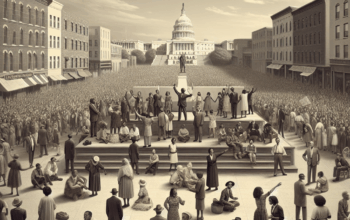The evolution of voting rights across nations has been a dynamic and multifaceted journey, reflecting societal changes, political struggles, and the ongoing fight for equality. Since the inception of democratic governance, the right to vote has been a critical aspect of citizen engagement and political representation. This article delves into the significant milestones in the global evolution of voting rights, examining historical contexts, regulatory changes, and the current state of voter access as of 2025.
The Foundations of Voting Rights: A Historical Perspective
The roots of voting rights can be traced back to ancient democracies, such as those in Athens, where free male citizens could participate in direct democracy. However, this representation was limited, as women, slaves, and foreigners were excluded. The concept of universal suffrage began to take shape during the Enlightenment, with philosophers like John Locke and Rousseau advocating for individual rights and the social contract, which laid the groundwork for broader voting privileges. Initially, voting was concentrated among landowners and the elite, reflecting societal hierarchies that persisted for centuries.
As societies progressed into the 19th and 20th centuries, the labor and suffrage movements began to challenge these restrictive norms. This period saw landmark developments such as the passing of the 15th Amendment in the United States in 1870, granting African American men the right to vote. Similarly, countries like New Zealand led the way in women’s suffrage in 1893, inspiring other nations to follow suit. These early movements were crucial in shaping the discourse on voting rights, emphasizing the importance of inclusivity in democratic governance.
The 20th Century: A Turning Point in Voting Rights
The 20th century marked a significant turning point in the expansion of voting rights across nations. After World War I, several countries recognized the necessity of granting suffrage to women as a reward for their contributions during the war. This shift was undeniably influential, paving the way for the passage of various laws that allowed women to vote and stand for election. Countries such as Germany and Canada joined New Zealand in instituting women’s suffrage during the interwar period, further altering the political landscape.
As global movements continued to evolve, the latter half of the 20th century saw a wave of decolonization, resulting in numerous new nations emerging and establishing their voting rights frameworks. Newly independent countries often adopted more progressive constitutions and civic structures that included universal voting rights. This period also witnessed the Civil Rights Movement in the United States, culminating in the Voting Rights Act of 1965, which aimed to eliminate racial discrimination in voting. Countries around the world began to take heed of these developments, leading to changes in their own voting regulations to promote equality and combat discrimination.
Globalization and Digital Voting Rights: The 21st Century Influence
Entering the 21st century, the impact of globalization significantly influenced the evolution of voting rights. The interconnectedness of the world led to increased awareness and advocacy for democratic governance and citizen participation across borders. Various international organizations, such as the United Nations and the European Union, began to assert the importance of fair electoral processes and the protection of voting rights as fundamental human rights. The global push for democracy brought about significant changes in many nations, where democratic reforms were initiated in response to citizens demanding more access to political participation.
Moreover, the rise of technology has transformed the nature of voting and voter engagement. E-voting systems and mobile applications became more prevalent by the year 2025, allowing citizens to cast their votes conveniently and securely, even from remote locations. Countries like Estonia have been leading the way in implementing digital voting systems, ensuring transparency and accessibility. However, this technological shift has also introduced challenges, such as cybersecurity concerns and digital divides that may disenfranchise certain demographics. As jurisdictions continue to explore innovative voting methods, ongoing efforts are being made to safeguard the integrity of electoral systems while ensuring that all citizens can participate meaningfully.
The Current State of Voting Rights in 2025: Progress and Challenges
As we look at the current state of voting rights in 2025, notable advancements have been made, yet challenges persist. In many developed democracies, voting rights have become more expansive, with various initiatives aimed at increasing voter participation, especially among marginalized groups. Countries have implemented automatic voter registration, same-day registration, and mail-in ballots, reflecting a commitment to reducing barriers to voting. For instance, in the United States, a surge of voting rights legislation at the state level aimed to enhance accessibility and prevent voter suppression tactics that disproportionately affect minority groups. These measures reflect a growing recognition of the importance of inclusivity in democratic processes.
Conversely, in some parts of the world, the struggle for voting rights continues. Authoritarian regimes often suppress dissent and impose onerous restrictions on political freedoms, hindering citizens’ ability to vote freely. For example, various nations in the Middle East and North Africa still grapple with significant legal and social barriers to voting, particularly for women and young people. Even in democracies, the rise of populism and nationalism has resulted in regressive policies that threaten the very foundation of voter access. As international observers remain vigilant, the fight for equitable voting rights persists, emphasizing the significance of continuous advocacy and reform.
The Future of Voting Rights: Prospects and Innovations
Looking ahead, the future of voting rights appears poised for both potential breakthroughs and unforeseen challenges. The ongoing integration of technology in voting systems offers promising prospects for increased participation and efficiency. As innovations in blockchain technology and artificial intelligence gain traction, they hold the potential to enhance security and transparency in electoral processes. However, along with these advancements come the risks of misinformation and data breaches, necessitating robust legislation and protections to ensure that all citizens can exercise their voting rights without fear or manipulation.
Furthermore, as global demographics shift, the conversation around voting rights will likely evolve. With rising youth populations in many nations, younger voters will increasingly influence the electoral landscape. Engaging these younger demographics through educational initiatives and incorporating their perspectives into policy discussions will be vital for fostering a more inclusive democracy. As social movements gain momentum and amplify voices from various sectors of society, voting rights will remain a central topic in the quest for equality and representation.
Finally, addressing climate change and economic inequalities may also intertwine with the evolution of voting rights. As nations confront these pressing issues, ensuring that all citizens, particularly the most vulnerable, have a say in decisions that impact their lives will become increasingly critical. The future of voting rights is not merely about expanding access; it encompasses a holistic understanding of democracy as a vehicle for social justice and empowerment.
Conclusion
In summary, the evolution of voting rights across nations has been a complex interplay of historical struggles, political movements, and technological advancements. From ancient democracies to the digital age, the journey toward inclusive and fair electoral processes continues. While significant progress has been made, particularly in the 20th and 21st centuries, the fight for equitable voting rights is far from over. As we navigate the challenges of the present and embrace the opportunities of the future, it is imperative to remain vigilant and committed to securing the fundamental right to vote for all citizens around the globe.
FAQs Section
What were the major milestones in the evolution of voting rights?
Some major milestones include the introduction of women’s suffrage in various countries, the passage of the Voting Rights Act in the United States, and the recognition of voting as a fundamental human right in various international treaties.
How has technology impacted voting rights?
Technology has improved access to voting through innovations like online registration and e-voting; however, it has also introduced challenges such as cybersecurity risks and the digital divide that may disenfranchise certain populations.
What barriers to voting rights still exist today?
Barriers include voter suppression tactics, discriminatory laws, and political unrest in various regions, particularly affecting marginalized groups, women, and young voters.
What is the role of international organizations in promoting voting rights?
International organizations, such as the United Nations, play a crucial role in promoting and monitoring fair electoral processes, advocating for the protection of voting rights, and providing support to nations striving for democracy.
What does the future hold for voting rights globally?
The future of voting rights may be shaped by advancements in technology, evolving demographics, and the ongoing dialogue surrounding social justice and environmental issues, indicating that the journey toward equitable representation is an ongoing process.












